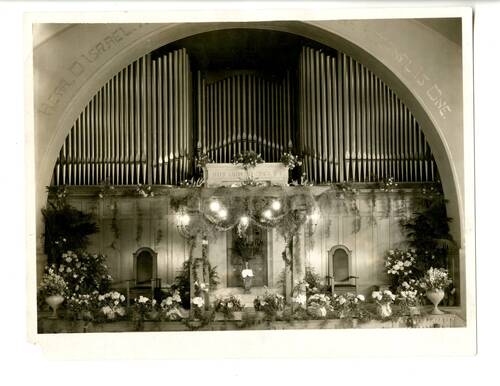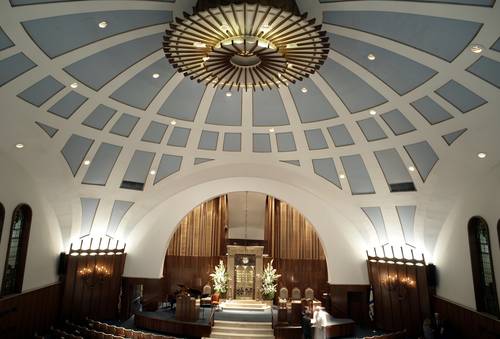THE SANCTUARY
The Sanctuary was designed to evoke feelings of awe and wonder. Upon entering, worshippers will notice the marble ark with the Hebrew inscription Know before whom you stand, the repeated Hebrew-letter shin motif symbolizing Sholom (peace) and Shaddai (one of God’s names, meaning holy), the Tiffany stained-glass windows, the dome high overhead with its Star-of-David, and the organ-choir loft above and behind the ark. The ark valance and ark Torah covers are the work of dedicated Sisterhood members; the valance contains the Hebrew words Rodef Sholom, meaning Pursuers of Peace, while the interior design includes the dove of peace holding the olive branch.
The twelve stained-glass windows were designed by Rabbi I.E. Philo to represent the 12 Tribes of Israel. Highlights on the south wall include the first window with a shofar, the ram’s horn blown at the High Holy Days; the second with the giving of the Ten Commandments at Mount Sinai; and the third with the Ark of the Covenant. The fourth window has the Holy of Holies shewbread table; the fifth the menorah (seven-branched candlestick) with inscription God is my light; and the sixth the altar in the Jerusalem Temple for sacrifices.

The north wall’s first window depicts the Ner Tamid, or perpetual light mirroring the Ner Tamid suspended from the ark itself, shaped to look like the world created; above it are a set of wooden beads in clusters from one to seven, reminding us of the six days of creation and the Sabbath day. The second window contains the breastplate of the high priest with the names of the 12 tribes; the third the vessel the priests used to cleanse themselves before entering the Temple; and the fourth the Kiddush cup of sanctification. The fifth window contains the Torah and the inscription Upon three things the world rests Bon Torah, on service to others, and on deeds of righteousness; and the last window depicts an open Bible, signifying our receptivity to God’s commandments.
HISTORY
On May 12, 1867, a group of 15 men met, chartered a constitution and by-laws, and divided themselves into three groups according to ability to pay dues. One week later they met again and adopted a name for the new congregation, Rodef Sholom (Pursuers of Peace). The members, most of whom were German immigrants, merchants, and shopkeepers, met and worshipped above a factory on Federal Street in downtown Youngstown.
Rodef Sholom was led with German discipline. Officers and committee members who did not attend services, who failed to make their reports on time, or who as parents interfered with the Sunday School Director were fined, as were those who “chewed tobacco during Devout Service.” Applications of new members were carefully screened and formally voted on. Dues were collected regularly and delinquents readily suspended and dropped.
The new congregation was very successful. By August 1867 burial grounds had been acquired. In 1868 Rabbi Lippman Liebmann was hired as “Preacher, Teacher, Reader, and Leader.” He conducted services in German and taught Sunday School and Hebrew, and served as Shochet for those members of the congregation who observed the dietary laws. The first Torah was dedicated on February 19, 1869.
Growth in membership meant growth in possessions and the need to find a larger, permanent home. In 1886 Rodef Sholom’s first building was dedicated at the comer of Lincoln and Fifth Avenue.
Rabbi Liebmann remained as “Minister of the Congregation” through the building of the synagogue in 1886. A number of leaders oversaw the further growth of the membership; in 1913 Rabbi I.E. Philo of Akron was installed, beginning a long and valuable ministry with Rodef Sholom. He was a great orator and recognized as the chief representative of the Jewish community.
With his installation, it was obvious that a much larger facility was necessary. The ground was broken on April 9, 1914 for what is the present-day Congregation Rodef Sholom facility on the comer of Elm and Woodbine Streets. Construction was rapid and the new building was dedicated June 11- 13, 1915 by Rabbi Philo as “the center of the Jewish community-a house of prayer, a house of study, and a house of assembly combined.” It was built with a particularly fine Indiana limestone and gray brick, in a Moorish design.
At the time it was described as “containing a high-domed sanctuary large enough to hold nearly 700 people, a two-story and fully-equipped Sabbath school of 12 rooms in the rear, and in the basement a social hall with a gymnasium, shower, baths, locker room, reading rooms, kitchen, and a stage large enough to hold 75 people.”
Sisterhood has been a part of Rodef Sholom since 1867, the year of its founding (first named the Ladies’ Mite Society, then the Ladies Hebrew Benevolent Society). Brotherhood began in 1924. In those days the synagogue was truly the center of spiritual, social, and educational Jewish activities. Boy Scout Troop 19 had been founded in 1913, the B’nai B’rith Lodge met there, and the synagogue was in effect the Jewish Community Center and Country Club of the time.
Membership gradually increased from 188 family units with 178 children in 1916, to 272 family units in 1930, 423 units in 1948, 651 units in 1957, and peaked at 710 units in 1967 with a religious school enrollment of 395 children. In 2015, after the merger with Temple Beth Israel of Sharon, PA, we now have 343 family units.
New arrivals from Europe after World War II and new arrivals from Russia in the 1990’s were extended invitations to join the Congregation without any financial obligations.
1942 saw Rabbi Philo’s retirement and the burning of the mortgage. The talented Dr. Abraham Fineberg was elected to be the new Rabbi, but only served three years when he suddenly became ill and tragically passed away. In 1946 Rabbi Sidney Berkowitz was called to assume the spiritual leadership of the Temple. He remained Rodef Sholom’s rabbi until his death in 1983, beloved by all for his leadership and kind nature.
Cantor Lawrence Ehrlich was hired in 1951. His operatic voice was renowned for its quality. He was also the religious school leader until his retirement in 1982.
During these years the Temple prospered. There were ecumenical worship services, many educational activities with guest lecturers, and great musical events.
There have been many renovations and additions to the building since 1915. The Strouss Memorial Social Hall was dedicated in 1948. The religious school wing and Tamarkin Chapel were added in 1955. Fourteen new classrooms, a youth lounge, newly-remodeled kitchen and the Wilkoff Library were welcome additions in 1960, along with the installation of air conditioning. A new portico was constructed on the face of the Temple in 1964, and its Holy Ark rededicated in 1987 in memory of Rabbi Berkowitz. The elevator wing was built in 1993, making Rodef Sholom fully accessible to all. And the sanctuary was renovated in 2001 with more spacious rows, refurbished seats, a makeover, a repaired roof, and more. In 2010, a generous donation from Milton and Cecilia Handler was used to create Handler Hall, utilized for Oneg Shabbats, meal functions and programs.
In 2019, Congregation Rodef Sholom hired their first Executive Director, Sarah Wilschek, of Youngstown. Together the congregation and Wilschek have a longterm vision for the future of our community.
Most recently, on November 1, 2021, Congregation Rodef Sholom merged with Ohev Tzedek -Shaarei Torah Congregation. Memorializing the history of Ohev Tzedek, Temple Beth Israel, and Rodef Sholom, the congregation was renamed Congregation Ohev Beth Sholom.
We remain the largest congregation in the Youngstown area with over 300 membership unites. In nearly 155 years there have been continuous services held, their orientation changing from that of its German founders, to Classical Reform, to modern progressive Reform. Following the November 2021 merger, we continue to offer Reform services and have added more traditional services on Saturday mornings. We are the only congregation with a Sisterhood and a Brotherhood. We still emphasize inclusive worship, youth and adult education, social action and social events.

 The north wall’s first window depicts the Ner Tamid, or perpetual light mirroring the Ner Tamid suspended from the ark itself, shaped to look like the world created; above it are a set of wooden beads in clusters from one to seven, reminding us of the six days of creation and the Sabbath day. The second window contains the breastplate of the high priest with the names of the 12 tribes; the third the vessel the priests used to cleanse themselves before entering the Temple; and the fourth the Kiddush cup of sanctification. The fifth window contains the Torah and the inscription Upon three things the world rests Bon Torah, on service to others, and on deeds of righteousness; and the last window depicts an open Bible, signifying our receptivity to God’s commandments.
The north wall’s first window depicts the Ner Tamid, or perpetual light mirroring the Ner Tamid suspended from the ark itself, shaped to look like the world created; above it are a set of wooden beads in clusters from one to seven, reminding us of the six days of creation and the Sabbath day. The second window contains the breastplate of the high priest with the names of the 12 tribes; the third the vessel the priests used to cleanse themselves before entering the Temple; and the fourth the Kiddush cup of sanctification. The fifth window contains the Torah and the inscription Upon three things the world rests Bon Torah, on service to others, and on deeds of righteousness; and the last window depicts an open Bible, signifying our receptivity to God’s commandments.

